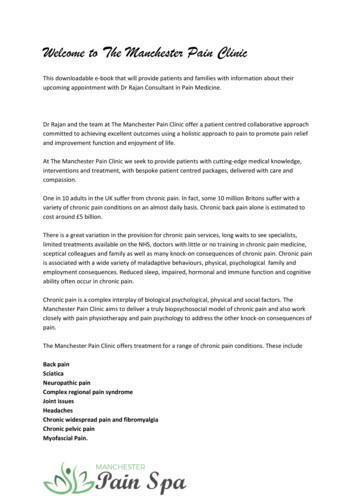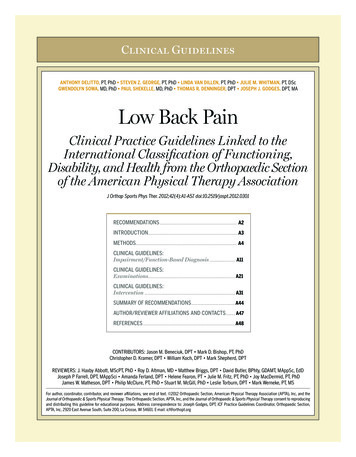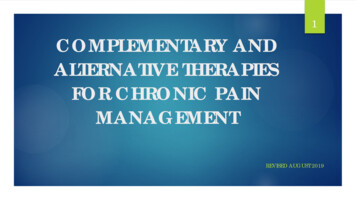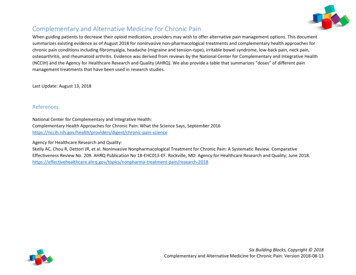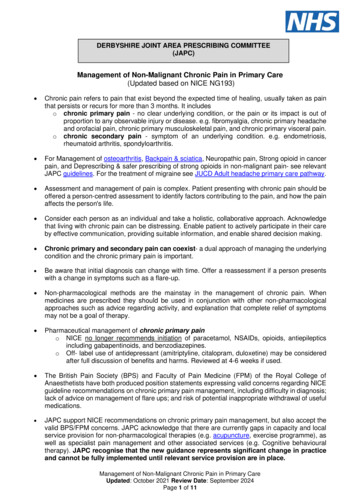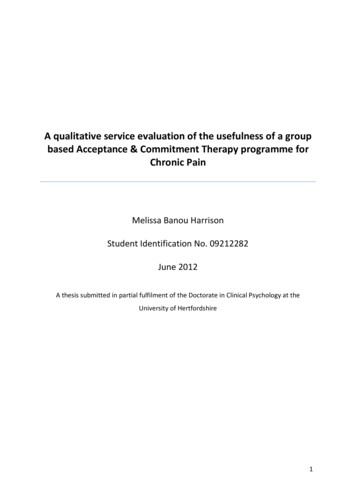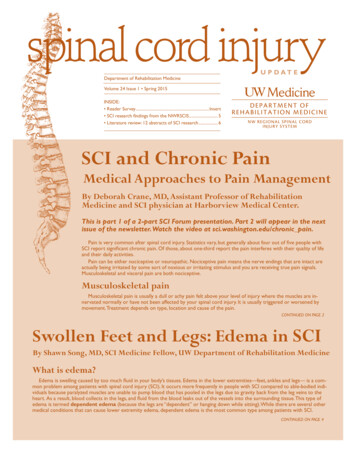
Transcription
Department of Rehabilitation MedicineVolume 24 Issue 1 Spring 2015INSIDE: Reader Survey.Insert SCI research findings from the NWRSCIS. 5 Literature review: 12 abstracts of SCI research. 6SCI and Chronic PainMedical Approaches to Pain ManagementBy Deborah Crane, MD, Assistant Professor of RehabilitationMedicine and SCI physician at Harborview Medical Center.This is part 1 of a 2-part SCI Forum presentation. Part 2 will appear in the nextissue of the newsletter. Watch the video at sci.washington.edu/chronic pain.Pain is very common after spinal cord injury. Statistics vary, but generally about four out of five people withSCI report significant chronic pain. Of those, about one-third report the pain interferes with their quality of lifeand their daily activities.Pain can be either nociceptive or neuropathic. Nociceptive pain means the nerve endings that are intact areactually being irritated by some sort of noxious or irritating stimulus and you are receiving true pain signals.Musculoskeletal and visceral pain are both nociceptive.Musculoskeletal painMusculoskeletal pain is usually a dull or achy pain felt above your level of injury where the muscles are innervated normally or have not been affected by your spinal cord injury. It is usually triggered or worsened bymovement. Treatment depends on type, location and cause of the pain.continued on page 2Swollen Feet and Legs: Edema in SCIBy Shawn Song, MD, SCI Medicine Fellow, UW Department of Rehabilitation MedicineWhat is edema?Edema is swelling caused by too much fluid in your body’s tissues. Edema in the lower extremities—feet, ankles and legs— is a common problem among patients with spinal cord injury (SCI). It occurs more frequently in people with SCI compared to able-bodied individuals because paralyzed muscles are unable to pump blood that has pooled in the legs due to gravity back from the leg veins to theheart. As a result, blood collects in the legs, and fluid from the blood leaks out of the vessels into the surrounding tissue. This type ofedema is termed dependent edema (because the legs are “dependent” or hanging down while sitting). While there are several othermedical conditions that can cause lower extremity edema, dependent edema is the most common type among patients with SCI.continued on page 4
spinal cord injuryUPDATEpain, continued from page 1Consider a power wheelchair. Manual wheelchair usersare often reluctant to switch to a power wheelchair. But if painhas reduced your mobility, switching to a power chair, at leastpart of the time, can actually increase your participation in activities you enjoy. Some guidelines say that if you get surgery foran upper limb issue you should use a power chair for the futurebecause you’re at risk of more upper limb injury.Back and neck painPeople with SCI often develop curves in the spine, such asscoliosis (sideways curve) or kyphosis (rounded back), and thisabnormal posture can become uncomfortable over time.Shoulder painLack of core strength due to paralyzed muscles often leadsto muscle imbalances and using shoulders to maintain posture ina way that becomes uncomfortable.Overuse from pushing your wheelchair or using a walkerover time can lead to arthritis of your shoulder joint or rotatorcuff tears.Elbow painPeople with weak trunk muscles often lean on their elbowsto hold themselves upright, causing painful bursitis or arthritis.The ulnar nerve of the arm can become pinched at theelbow over time, causing pain and weakness.Hands and wristsManual wheelchair users put a lot of strain on the carpal tunnel area in the front of the wrist (carpal tunnel syndrome).TreatmentsvIt is important to work with your physicaland occupational therapists (PTs and OTs)to make sure you are following good biomechanics so you can keep your joints as healthyas possible. There are several approaches totreating musculoskeletal pain:Exercise can be effective in improvingpain, and PTs and OTs can design an exerciseprogram specifically for your needs.Activity modification. Reducing orchanging the way you do things can allow thepainful area to rest. For example, if you areperforming 12 transfers a day while you do errands all over town, think about consolidatingsome of your activities to do fewer transfers.Wheelchair evaluation. If you are using amanual wheelchair and having musculoskeletalpain, a proper wheelchair fit is vitally important. A good fit enables you to have correct posture and supportfor your pelvis and back and to use correct body mechanicswhile propelling your chair.Weight control. The less weight you have to haul around,the less strain you put on your upper body. It’s hard to loseweight when you are limited in what activities you can do, butyour therapists can help you find some options.Injections. Cortisone injections can be helpful for temporary pain management. Remember to rest your upper limbimmediately after getting an injection to avoid the possibility ofa tendon rupture.Surgery. Surgery is sometimes an option when other methods don’t work. Keep in mind that you may need to completelyrest the affected limb for several weeks and even months aftermajor upper limb surgery. With one arm out of commission,you may need almost full time help or a stay in a nursing facilitywhile healing.Visceral painThis refers to pain in the abdominal area. It is often describedas dull, achy, or crampy pain that comes and goes. It can bevague and hard to describe, especially if you don’t have normalsensation in that area.Visceral pain is caused by some sort ofabdominal problem that needs treatment, such as constipation,kidney stones, ulcers, appendicitis, bladder stones, gallstones, ora gastrointestinal virus.Neuropathic painvIn contrast to nociceptive pain, neuropathic pain is causedby abnormal communication between the damaged nerves inyour spinal cord and the pain centers of your brain. The pain isoften described as pins and needles, burning,throbbing or stabbing. It can be at the level ofinjury, where your sensation or your strengthchanges, above the level of injury, or belowthe level of injury. Usually there is not a specific trigger for the pain, and the pain is oftenfairly constant.Neuropathic pain is complex and usuallyrequires a combination of treatments. Thefirst step is always to see if there is any medical complication causing the pain.Your healthcare provider can help with this.vNeuropathic painis complex andusually requires acombination oftreatments.v2 Volume 24, Issue 1Spinal Cord Injury Updatespring 2015vMedicationsSeveral different medications can be usedto treat neuropathic pain, sometimes in combination.Acetaminophen (Tylenol). Often overlooked because people may not think it’sstrong enough, for many patients it is helpful,especially in combination with other medications.Antidepressants. There are two major types commonlyused for nerve pain. TCAs or tricyclic antidepressants -- most commonly amitriptyline and nortriptyline. Major side effects are dry mouth,constipation, and urinary retention, which for some peopleare intolerable. Otherwise it’s pretty safe, and for manypeople it is very effective.v Serotonin norepinephrine reuptake inhibitors (SNRIs) can beeffective in treating nerve pain. Common examples are venlafaxine (Effexor) and duloxetine (Cymbalta). The main sideeffects are GI or stomach upset, or high blood pressure.Anticonvulsants. Seizure medicines such as gabapentin andpregabalin (Lyrica) also work well against nerve pain. First-generation anticonvulsants like carbamazepine (Tegretol), phenytoin (Dilantin), and valproate (Depakote) can becontinued on next page
spinal cord injuryUPDATEcontinued from previous pageeffective. Some of these medications require periodic bloodtests. Second generation anticonvulsants are more commonbecause they don’t need such monitoring. These includegabapentin (Neurontin) and pregabalin (Lyrica). The mainside effect is sedation, but otherwise they are usually welltolerated.NSAIDs (nonsteroidal anti-inflammatory drugs) suchas ibuprofen (Advil), naproxen (Aleve), and celecoxib (Celebrex)are not frequently used for nerve pain, but they sometimes can behelpful in combination with other drugs. Side effects are mild, buttaking too much for too long can damage kidneys.Opioids (narcotic medications)Most people with SCI had opioids when they were firstinjured and still in the hospital. These drugs come in either longacting (lasting 8-12 hours and including methadone, morphine,oxycodone, and fentanyl) or short-acting (2-4 hours, such asmorphine, oxycodone, hydrocodone and hydromorphone)formulations. Short and long-acting medications are often prescribed together, to combat the spikes of intense pain that breakthrough the long-acting dose.Side effects of Opioids Constipation. These medicines slow down everybody’s gut,so whether you’ve got spinal cord injury or not they’re goingto make you constipated. Since many people with SCI alreadystruggle with having regular bowel movements, narcotics canmake the problem much worse. Dependence. Anyone who takes opioids for a long timewill develop some physiologic dependence. That doesn’tmean you’re a drug addict, but rather that your body hasbecome accustomed to that medication, so that if you stopabruptly you will have some withdrawal symptoms. Sedation. Sleepiness is a common side-effect of opioids. Tolerance. This is the idea that your body starts to needmore and more of the medication as time goes on in orderto get the same benefit. So if 5 milligrams of a opioid reallytook care of your pain, after a couple months you may needto increase that to 10 milligrams. And this continues: after afew months on 10 milligrams, you’ll start needing 15. That’sone reason why long term use of opioids can be a problem. Addiction. This is a risk if you do not take opioids as prescribed.MarijuanaMarijuana (cannabis) has been found to be effective in reducing nerve pain and spasticity in some studies of people with SCIand other disabilities. Go to http://sci.washington.edu/marijuana fora comprehensive discussion of medical marijuana for SCI pain.SurgerySurgery for nerve pain is not common but may be helpfulin a few specific cases, such as a pinched nerve in your spine(nerve root compression) or a peripheral nerve injury such asan ulnar nerve injury at the elbow or carpal tunnel syndrome.Likewise, syrinx formation (a cyst in the spinal cord) or nerveroot tethering (nerves stuck in scar tissue) may require surgery.AcupunctureAcupuncture is considered a neurostimulatory technique inwhich needles are inserted in various points in the skin. Whilesome people say it works well, research has not found it to beeffective. It doesn’t really have any negative side effects, however,and may be worth a try.Massage therapyTopicalsThere is research data that shows people with SCI use massage as a frequent pain treatment and find it effective. Some butnot all insurers pay for therapeutic massage.Medications that you rub onto your skin can be helpful forsome kinds of pain, but they are only practical for small areas ofthe body. Capsaicin. The active ingredient in these creams comesfrom chili pepper. Capsaicin tends to work better if you useit multiple times throughout the day.TENS stands for transcutaneous electrical nerve stimulationand uses electric current delivered through patches applied tothe skin. TENS is often most useful for pain in a specific area,such as SCI pain at your level of injury, radicular or nerve roottype pain, or musculoskeletal pain. Lidocaine is a numbing medicine similar to what the dentistgives you in a shot form. Lidoderm patches are stickers withthe lidocaine medication impregnated in them. They canbe very expensive and are not covered by many insurancecompanies. Diclofenac or voltaren gel is an anti-inflammatory gel.TENS unitHeat and iceHeat and ice can be helpful for individuals with muscular pain.Do not to apply heat or ice to areas of your body that don’thave normal sensation, however, because you can get burns orfrostbite.University of Washington School of MedicineDepartment of Rehabilitation Medicine 3
spinal cord injuryUPDATEEdema, continued from page 1vPhysical SignsThough you can usually tell whether edema is present just bylooking, legs can sometimes appear normal if the edema is mild.A reliable way to detect edema is by pressing a finger into theskin over the lower shin. If an indentation remains for severalseconds after removing your finger (called “pitting”), lowerextremity edema is present (see figure 1).You can also examinethe skin under your sock – an indentation left by the sock is anindicator of edema.If leg swelling is asymmetric (not the same in both legs), thismay be a sign of a more serious medical condition. For example,blood clots in the veins of the leg, a bony fracture, or an abnormal bone formation called heterotopic ossification, can all resultin new, asymmetric leg swelling and require immediate medicalattention.You should always let your medical provider know ifyou have any new leg swelling, even if in both legs, since this maybe a sign of a new or worsening medical condition.ConsequencesThe major consequences of dependent edema involve theskin. Dependent edema, especially if long-standing, can cause theskin to become thin, fragile, and more vulnerable to breakdown.Significant foot swelling can cause shoes to fit poorly, potentiallyvvLong-standing edemacan cause skin to becomethin, fragile, and morevulnerable tobreakdown.vvvleading to pressure ulcers. If you already have a pressure ulcer,dependent edema can prevent or delay healing. Finally, dependent edema is a risk factor for infections of the skin of the legs,known as cellulitis. Be sure to seek immediate medical attentionif you have edema along with new redness and/or warmth, sincethis may be a sign of cellulitis.TreatmentLeg elevationElevating the legs reduces the effect of gravity and helps thefluid that has collected in the lower legs to drain back to theheart. The higher your legs are relative to the level of your heart,the faster fluid will drain out of your legs. For example, lying inbed with the feet at the level of your heart is generally better than raising your legs while seated. However, lying in bed isnot always practical, so you can extend your legs from a seatedposition or perform tilt-backs in a power wheelchair at regularintervals to minimize fluid collection in the legs. Small studieshave shown that elevating the feet by as little as 30 degrees for15 minutes reduces the amount of lower extremity edema.Precautions Take care to protect your skin while elevating your legs. Ifyou are sitting down with knees straight and heels resting ona chair, make sure your heels are on a cushioned surface forno longer than 15 minutes in order to prevent a pressureulcer. Another concern is the possibility of increased urine outputas the lower extremity edema resolves. For example, if youhave significant dependent edema and get into bed, the fluidfrom your legs returns to circulation, and your urine outputovernight may be greater compared to during the day.Youtherefore may need to self-catheterize more frequently atnight as a result of increased urine output.Compression stockingsFigure 1Credit: Mayo Foundation Medical Education and Research. Used by permission.There are two main types of compression stockings—gradient and anti-embolism. Gradient compression stockings arethe type appropriate for the majority of SCI patients. Gradientcompression stockings are constructed so that the compression level is highest (or tightest) at the ankle and less at theContinued on next page4 Volume 24, Issue 1Spinal Cord Injury Updatespring 2015
spinal cord injuryUPDATEContinued from previous pageMedicationstop of the hose. This pressure gradient helps to minimize fluidcollection in the legs and return blood to the heart. Gradientcompression stockings come in different compression levels andcan also be custom-made. There are also different lengths ofstockings, from knee-high to thigh-high.You should put on the compression stockings in the morningbefore getting out of bed, as your legs will have the least amountof fluid at that time. Make sure the stockings do not bunch orwrinkle as this can cause increased pressure over these areas.Consult a medical professional to determine the compressionlevel and appropriateness of gradient compression stockings.Precautions You should not wear compression stockings if you haveperipheral artery disease (PAD). If there is any question ofPAD, you will need to have a vascular evaluation including anankle-brachial index.Diuretic medications, which help the body shed water, cantreat some forms of edema. However, we do not recommendroutine use of diuretics for dependent edema, as these medications can have unwanted side effects, especially related to lowblood pressure.Summary1. Dependent edema is a common problem among individualswith SCI.2. Dependent edema is caused by blood pooling in the legveins, with fluid from the blood then leaking out of the vessels into the surrounding tissue.3. Potential consequences of dependent edema include fragileskin, pressure ulcers, and infection of the skin called cellulitis.4. New or asymmetric leg swelling may be a sign of a moreserious medical condition and requires medical attention. You should not wear compression stockings if you have active cellulitis of the lower extremities.5. Treatments include leg elevation and compression stockings. If you are susceptible to autonomic dysreflexia, speak toyour SCI physician before using compression stockings.6. Compression stockings should be prescribed by a medicalprofessional. If you have impaired hand function you will need to be supervised the first time you put on compression stockings tomake sure you are putting them on correctly.7. Patients should closely monitor the skin over their legs forsigns of irritation when elevating them or when first usingcompression stockings. Make sure to closely monitor your skin for evidence of irritation or breakdown when first using compression stockingsand remove stockings at the first sign of skin irritation.vvvvvUW Researchers Publish Landmark Study of Depression and SCIDepression is a common problem in people with spinal cord injuries, and serious depression (called major depressive disorder orMDD) occurs in 25% to 30% of this population. MDD not only lowers quality of life but also has a negative effect on rehabilitation,independence, employment and social and leisure activities. It even can contribute to the development of pressure ulcers and urinarytract infections. Unfortunately, there has been little research to identify effective treatments for MDD in people with SCI.In response, Charles Bombardier, PhD, and Jesse Fann, MD, at the University of Washington (UW), conducted a randomized,double-blind, placebo-controlled trial called Project to Improve Symptoms and Mood After SCI (PRISMS), to determine the effectiveness and tolerability of the antidepressant medication venlafaxine hydrocholoride extended-release (XR) for MDD in individuals withSCI. This study included 133 individuals with SCI and MDD from outpatient clinics at six SCI treatment centers in the U.S. (includingthe UW). Seventy-four percent of participants were male, with an average age of 40 and average of 11 years since injury. Participantswere randomly (by chance) assigned to receive 12 weeks of treatment with either venlafaxine XR or placebo (fake pill). Each participant completed depression interviews before and after treatment. This was a double-blind study, meaning neither the participants northe investigators knew who was assigned to which group until the study was finished.Results showed that venlafaxine XR was well tolerated by most patients and an effective antidepressant for decreasing core symptoms of depression and improving SCI-related disability.These findings were published in the Journal of the American Medical Association Psychiatry:JAMA Psychiatry. 2015 Mar 1;72(3):247-58. Venlafaxine extended-release for depression following spinal cord injury: arandomized clinical trial. Fann JR, Bombardier CH, Richards JS, Wilson CS, Heinemann AW, Warren AM, Brooks L, McCullumsmithCB, Temkin NR, Warms C, Tate DG; PRISMS Investigators.Read more research findings from the Northwest Regional SCI System investigators athttp://sci.washington.edu/projects and research/abstracts.asp.University of Washington School of MedicineDepartment of Rehabilitation Medicine 5
literature reviewThe articles previewed below were selected from a recent screening of the National Library of Medicine database for articles on spinal cord injury. In the judgment of the editors, they include potentially useful information on the diagnosis or management of spinal cord injury.You may obtain copies of the completearticles through your local medical library or from UW Health Sciences Library Document Service (http://www.lib.washington.edu/ill).Cell-Based therapiesHeart Diseasen The known-unknowns in spinal cord injury, with emphasison cell-based therapies - a review with suggestive arenas forresearch.In spite of extensive research, the progress toward a cure in spinal cordinjury (SCI) is still elusive. Seven known gray areas in SCI cure researchare: i) the gap between animal models and humans; ii) uncertainty aboutthe time, route and dosage of cells applied; iii) source of the best cellsfor therapy; iv) inability to address the vascular compromise during SCI;v) lack of non-invasive methodologies to track the transplanted cells; vi)need for scaffolds to retain the cells at the site of injury; and vii) physical and chemical stimuli that might be required for synapses formationyielding functional neurons. To improve outcomes, further research isneeded on scaffolds for retaining the transplanted cells at the lesion,chemical and physical stimuli that may help neurons become functional,a meta-analysis of timing of the cell therapy, mode of application andlarger clinical studies.Dedeepiya VD,William JB, Parthiban JK, et al.Expert Opin Biol Ther. 2014 May;14(5):617-34.n Self-reported physical activity and risk markers for cardiovascular disease after spinal cord injury.Cardiovascular disease markers (hypertension, blood glucose and ablood lipid panel) were analysed in a group of 134 wheelchair-users(103 men, 31 women) with paraplegia due to SCI of at least a year’sduration. Participants reported on the type and extent of their physicalactivity. Physical activity of at least 30 minutes a day positively influenced diastolic blood pressure. No other reductions in cardiovasculardisease risk markers were seen after controlling for age. Men had significantly higher systolic and diastolic blood pressures than women, lowerhigh-density lipoprotein cholesterol, higher low-density lipoproteincholesterol/high-density lipoprotein cholesterol ratio and higher triglycerides. No other significant differences between men and women werefound. These results indicate a positive effect of physical activity, but itcannot be concluded that recommendations about physical activity incardiovascular disease prevention for the general population apply towheelchair-users with spinal cord injury.Flank P, Fahlström M, Boström C, et al.J Rehabil Med. 2014 Oct;46(9):886-90.n Autograft-derived spinal cord mass following olfactory mucosal cell transplantation in a spinal cord injury patient: Casereport.Human neural stem cells and cell transplantation are being investigatedas potential therapies for spinal cord injury (SCI), neurodegenerativediseases and other conditions. However, significant concerns have beenraised over the safety of this experimental therapeutic approach dueto the possibility of tumor formation. This report describes the caseof an 18-year-old women with T10-11 complete SCI who, three yearsafter injury, underwent olfactory mucosal cell implantation at the siteof injury. This procedure took place outside the U.S. She developedback pain 8 years later, and imaging showed a spinal cord tumor at thesite of cell implantation, which had to be surgically removed. Intraoperative findings revealed an expanded spinal cord with a multicysticmass containing large amounts of thick mucus-like material. Histological examination and immunohistochemical staining revealed that themass was composed mostly of cysts lined by respiratory epithelium,submucosal glands with goblet cells, and intervening nerve twigs. This isthe first report of a human spinal cord mass complicating spinal cordcell transplantation and neural stem cell therapy. Given how many yearsit took for the tumor to develop, patients with cell transplantation andneural stem cell implantation should be monitored for many years.Dlouhy BJ, Awe O, Rao RC et al.J Neurosurg Spine. 2014 Oct;21(4):618-22.Infectionn Community-associated Clostridium difficile infectionamong veterans with spinal cord injury and disorder.The impact of community-associated Clostridium difficile infection(CA-CDI) on patients with spinal cord injuries and disorders (SCI/Ds)is not fully understood. The authors examined CA-CDI cases amongveterans with SCI/D, comparing them with community-onset, healthcare facility-associated (CO-HCFA) cases. Generally, patients withCA-CDI had less comorbidity, less severe CDI, and lower likelihood ofantibiotic exposure.Balbale SN, Johnson S, Burns SP, et al.Infect Control Hosp Epidemiol. 2014 May;35(5):577-80.6 Volume 24, Issue 1Spinal Cord Injury Updatespring 2015n Ambulatory blood pressure monitoring in spinal cord injury:clinical practicability.After SCI, the loss of autonomic control over the cardiovascular systemcan cause blood pressure (BP) changes that may lead to increasedcardiovascular disease (CVD) risk. Subjects with complete tetraplegiashow the worst BP changes. Outpatient management of BP in thispopulation is becoming increasingly important. In addition, SCI subjectsare living longer and their risk for CVD may be increased. The useof ambulatory blood pressure monitoring (ABPM) allows insightsinto circadian BP profiles and have been shown to supply importantinformation about CVD risks in able-bodied subjects. ABPM can bea helpful, non-invasive tool to look at changes in circadian BP patterns and factors related to episodes of orthostatic hypotension andautonomic dysreflexia. Further, abnormal patterns in ABPM, such as aloss of nocturnal dip, have been shown to be associated with increasedrisk for CVD in the able-bodied population. Therefore, presence of potentially life-threatening AD events as well as abnormal ABPM patterns,also might pose potential CVD risk factors in the SCI population. Thisrelation is not well documented yet in patients with SCI but will beparticularly important for people with complete tetraplegic who showadverse circadian BP profiles. The use of ABPM in this population mighthelp detect these profiles and monitor the efficacy of various treatmentstrategies. Although further research is required in this area, we suggestthat ABPM should be used to assess BP changes in patients with SCI.Hubli M, Krassioukov AV.J Neurotrauma. 2014 May 1;31(9):789-97.Walkingn Understanding therapeutic benefits of overground bionicambulation: exploratory case series in persons with chronic,complete spinal cord injury.Two men and one woman aged 26 to 38 years with chronic completeSCI (American Spinal Injury Association Impairment Scale grade A)between the levels of T1 and T10 participated in an overground bionicambulation (OBA) program using the Ekso Bionic lower extremity robotic exoskeleton. The program consisted of one-hour trainingsessions three times per week for six weeks. Even though there waslittle or no improvement in either activation of leg muscles or exerciseconditioning after the program, participants reported lower overallcontinued on next page
literature reviewspinal cord injuryUPDATEcontinued from previous pagepain severity, lower intensity of at-level neuropathic pain, and reducedsleep problems. Whether extended use would result in more favorablechanges remains to be determined in follow-up studies.Kressler J,Thomas CK, Field-Fote EC, et al.Arch Phys Med Rehabil. 2014 Oct;95(10):1878-1887.n Repetitive mass practice or focused precise practice forretraining walking after incomplete spinal cord injury? A pilotrandomized clinical trial.A randomized, single-blind, crossover design was used to contrast 2methods of retraining, one emphasizing precise, visually guided walkingover obstacles and on targets (Precision Training), the other emphasizing mass practice of walking on a treadmill (Endurance Training).Twenty-two participants, at least 7 months postinjury, started Precisionor Endurance Training. Each phase of training was 5 times per week for2 months, followed by a 2-month rest. Both forms of training led to significant improvements in walking, with Endurance Training resulting inbigger improvements in walking distance, especially for high-functioningwalkers. The largest improvements in walking speed and distance occurred in the first month of Endurance Training, with minimal changesin the second month of training. In contrast, improvements in walkingskill occurred over both months during both types of training. Retention of over ground walking speed, distance, and skill was excellent forboth types of training. Intensive walking training is effective in improvingover ground walking in this population.Visually guided tasks for trainingindividuals with chronic spinal cord injury were not better than masspractice on a treadmill.Yang JF, Musselman KE, Livingstone D, et al.Neurorehabil Neural Repair. 2014 May;28(4):314-24.Spasticityn Effects of vibration on spasticity in individuals with spinalcord injury: a scoping systematic review.Spasticity can lower quality-of-life by causing pain
Back and neck pain People with SCI often develop curves in the spine, such as scoliosis (sideways curve) or kyphosis (rounded back), and this abnormal posture can become uncomfortable over time. Shoulder pain Lack of core strength due to paralyzed muscles often leads to mus


